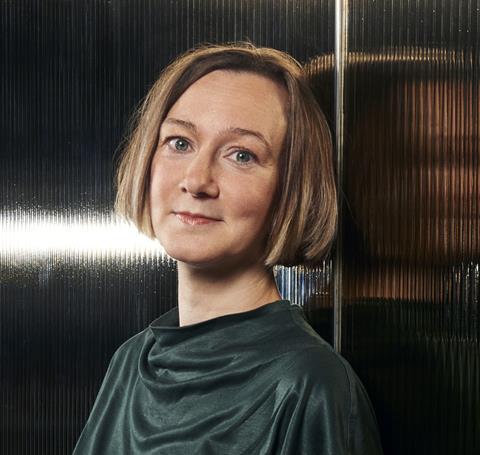Embodied carbon has primarily been a consideration at construction level but the impact of fit-outs over a building’s lifetime on the overall carbon footprint can no longer be ignored, writes Anja Schellenbauer
The construction industry is a complex animal. It is constantly adapting – for better or worse – to an ever-changing environment, much like a species evolving to secure its survival.

In response to its clear responsibility to reduce carbon emissions, the sector has come together in an unprecedented spirit of collaboration and shared thought leadership on how to decarbonise the built environment. Operational energy targets are now at an all-time low.
While this will take time and significant resources to implement across existing building stock, the industry is turning its attention to embodied carbon. Despite the disincentivising lack of tax relief on retrofit projects, developers are – more often than not – promoting the re-use of existing building assets, significantly reducing the embodied carbon of projects.
To date, what has been lacking are clear targets. While the RIBA, LETI and RICS have all championed carbon targets and methodologies to point the industry in the right direction, the UK Net Zero Carbon Buildings Standard (UKNZCBS) is the first industry-wide initiative to set carbon requirements for all building sectors, due to be published shortly.
The industry should look for mechanisms to hand over the baton from the developer’s team to the occupier’s team and place environmental responsibility on end users to fulfil their share of the whole-life carbon equation
Unlike other initiatives, the standard´s remit will include Cat B fit-outs. Until now, embodied carbon has primarily been a consideration at building level, not taking account of the interior’s carbon contributions. This is not by design and merely reflects the extent of the original project team’s remit, before a different team designs, procures and delivers the fit-out.
The industry should look for mechanisms to hand over the baton from the developer’s team to the occupier’s team and place environmental responsibility on end users to fulfil their share of the whole-life carbon equation.
This is not to say that occupiers shy away from environmentally friendly design; on the contrary, it is top of their agenda, albeit with a people-centric focus.
Fit-out design has evolved from maximising occupancy to wellbeing-led approaches. These focus on sensorially stimulating spaces that people enjoy being in, with a “softer” approach often achieving high levels of productivity simply by putting people at the heart of the design.
>> Also read: What the Future Homes Standard means for net zero
>> Also read: The UK is setting the standard for energy-efficient homes but there is still some way to go
Rarely do occupiers look at the “hard” carbon figures behind inspiring designs, as carbon accounting for fit-out remains in its infancy. Thomas Lane’s recent article in Building highlights their often temporary nature and associated carbon wastage. This “throwaway” culture of the almost instant removal of brand-new Cat A installations has been a bugbear of sustainability professionals for many years.
There is a curious discordance between Cat A installations driven by perceived market demands and leaseholders’ preferences to rent spaces with high sustainability credentials. But considerations should go far beyond Cat A; the carbon effect of Cat B fit-outs and, more importantly, their replacement cycle has been largely overlooked.
The maths here is simple. The upfront carbon of the shell and core is a one-off cost, justified over a theoretical 60-year lifespan. On average, a typical first fit-out equates to roughly a quarter of the building’s carbon cost.
What should concern us is the fit-out’s significantly lower lifespan and its dependency on wider factors, not directly related to the construction sector. Fit-out replacement cycles are driven by the volatility of financial markets, expansion and contraction of occupier needs, shifting lease terms, changes in corporate leadership and simple “out-with-the-old” attitudes.
Against this backdrop, fit-out effectively amounts to a carbon subscription cost – similar to operational carbon, but with a much higher impact on overall emissions.
The real issue is around frequency. As a rough rule of thumb, a replacement cycle of 15 years would result in an equal carbon split between building and interiors at the end of the buildin’s predicted lifespan. Any more frequent than this (typical leases are five, seven or 10 years) and we need to acknowledge that Cat B fit-out – and not the building fabric – is the carbon heavyweight.
An upfront carbon budget allocation over the lease term could establish a chain of custody for carbon emissions
Going forward, the industry needs to widen its perspective to fully understand a project’s tripartite carbon impact: across the shell and core’s one-off upfront carbon; continuous operational emissions; and the cyclical embodied carbon of its interiors. It is crucial to bring the leaseholder into the fold, but transparency and data-sharing will only be a starting point.
Tentative debates investigate the inclusion of sustainability requirements within lease agreements; an upfront carbon budget allocation over the lease term could establish a chain of custody for carbon emissions.
Equally, the first fit-out and every subsequent replacement need to be fed back into the building’s whole-life cycle assessment to maintain a “golden thread” of the building´s carbon footprint, mechanisms for which will need to be established.
No doubt more work will be done on this topic by the UKNZCBS in coming years and, given the extensive cross-section of professions involved, I am optimistic that the UKNZCBS will continue to build consensus on targets and procedures that can find wide adoption within the industry.
Anja Schellenbauer is associate director at John Robertson Architects and a member of the Sustainable Design Collective. She contributes to the UKNZCBS Office Sector Embodied Carbon Group.



























No comments yet